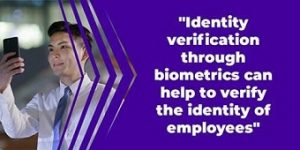
With the global digital transformation, many of the interactions that enterprises have with their customers are shifting online, where identity verification must be done remotely. Now banks, mobile operators, and other enterprises must enroll and authenticate their customers without ever meeting them face-to-face, and they must do it in a way that is secure, convenient, and complies with regulations.
“Identity verification is fundamental to how enterprises interact with their customers. It builds mutual trust between both parties and allows them to perform transactions both online and in-person.” says Avneesh Prakash, Head of Digital Identity, Idemia, Here, Prakash discusses the rise in remote ID verification and which sectors benefit from it.
Traditional enterprises and service providers can benefit tremendously from remote identity verification. This includes financial institutions, mobile network operators, insurance providers, sharing- and gig economy platforms, eCommerce companies, and online gaming services, just to name a few. Digital transformation has fuelled interest in remote identity verification in some sectors and has sparked the creation of new use cases in others.
Telehealth
In telehealth, providers enable both patients and doctors to conduct a virtual visit without having to meet face-to-face, reducing the risk of spreading disease to care providers or other patients at a care facility. Identity verification must be done on both sides to establish trust, verify the patient’s identity.
Online education
The verification of student identities is an important factor in the successful implementation of a distance learning programme. While a wide array of effective and trusted authentication methods are available, these methods still do not document that the student who is authenticated is actually the one who is taking the exam. Verifications such as biometric user verification and keystroke recognition (behavioural biometrics) can solve the key challenges in distance/online education.
Remote hiring
Increasingly, people are looking for remote jobs and prefer working from the comfort of their homes rather than travelling to an office for a desk job. Remote job openings are on a massive growth path — with some research showing an estimated increase of more than 150% since 2018. Digital biometric identity verification is essential in curbing issues such as fake documents, by enabling the verification and authentication of a candidate’s identity against the provided documentation.
Remote work
As more and more employees work from home, IT support teams are tasked with password and account recoveries – both of which require a trusted identity. Enterprises must ensure that all data is secure and protected from data leaks. Identity verification through biometrics can help to verify the identity of employees accessing this data, regardless of where they are located.
ID documents
Individuals use their smartphone to capture their ID document, passport or driver’s license. The data is then verified for authenticity with a trusted third-party or a root of trust.
Fingerprints
Individuals can use the camera of their own smartphones to capture and verify multiple fingerprints in a contactless and non-intrusive manner.
There are a variety of remote identity verification technology solutions to create a secure, compliant and seamless identity verification solution combining biometrics, document authentication, and other techniques. These areas include ID authentication for government benefits, selfies, video conferencing, behavioural analytics and voice signature identification for activation of devices, for example.
Idemia’s digital identity platform enables service providers to enroll, manage, and authenticate the digital identities of an organisations’ customers. The solution enables the entire lifecycle of a digital identity from the moment that it is created, to its use by any number of parties for secure and trusted authentication, all while remaining subject to a user’s consent.











